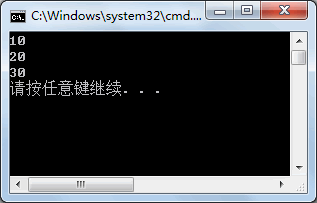C#泛型类的定义及使用
[ 2022-01-23 15:19:39 | 作者: admin ]
C# 语言中泛型类的定义与泛型方法类似,是在泛型类的名称后面加上<T>,当然,也可以定义多个类型,即“<T1,T2,・・・>”。
具体的定义形式如下。
这样,在类的成员中即可使用 T1、T2 等类型来定义。
下面通过实例来演示泛型类的使用。
【实例】定义泛型类,并在泛型类中定义数组,提供添加和显示数组中全部元素的 方法。
根据题目要求,代码如下。
在 Main 方法中调用 MyTest 类中的方法,代码如下。
执行上面的代码,效果如下图所示。
从上面的执行效果可以看出,根据泛型类中指定的数据类型创建数组,并实现了对数组元素的添加和显示。
C# 泛型多种参数类型与多重约束 示例
 评论Feed: http://blog.xg98.com/feed.asp?q=comment&id=2822
评论Feed: http://blog.xg98.com/feed.asp?q=comment&id=2822
具体的定义形式如下。
class 类名<T1,T2,…>
{
//类的成员
}
{
//类的成员
}
这样,在类的成员中即可使用 T1、T2 等类型来定义。
下面通过实例来演示泛型类的使用。
【实例】定义泛型类,并在泛型类中定义数组,提供添加和显示数组中全部元素的 方法。
根据题目要求,代码如下。
class MyTest<T>
{
private T[] items = new T[3];
private int index = 0;
//向数组中添加项
public void Add(T t)
{
if (index < 3)
{
items[index] = t;
index++;
}
else
{
Console.WriteLine("数组已满!");
}
}
//读取数组中的全部项
public void Show()
{
foreach(T t in items)
{
Console.WriteLine(t);
}
}
}
{
private T[] items = new T[3];
private int index = 0;
//向数组中添加项
public void Add(T t)
{
if (index < 3)
{
items[index] = t;
index++;
}
else
{
Console.WriteLine("数组已满!");
}
}
//读取数组中的全部项
public void Show()
{
foreach(T t in items)
{
Console.WriteLine(t);
}
}
}
在 Main 方法中调用 MyTest 类中的方法,代码如下。
class Program
{
static void Main(string[] args)
{
MyTest<int> test = new MyTest<int>();
test.Add(10);
test.Add(20);
test.Add(30);
test.Show();
}
}
{
static void Main(string[] args)
{
MyTest<int> test = new MyTest<int>();
test.Add(10);
test.Add(20);
test.Add(30);
test.Show();
}
}
执行上面的代码,效果如下图所示。
从上面的执行效果可以看出,根据泛型类中指定的数据类型创建数组,并实现了对数组元素的添加和显示。
C# 泛型多种参数类型与多重约束 示例
interface IMyInterface
{
}
class Dictionary<TKey, TVal>
where TKey : IComparable, IEnumerable
where TVal : IMyInterface
{
public void Add(TKey key, TVal val)
{
}
}
{
}
class Dictionary<TKey, TVal>
where TKey : IComparable, IEnumerable
where TVal : IMyInterface
{
public void Add(TKey key, TVal val)
{
}
}
[最后修改由 admin, 于 2022-01-23 15:27:55]
 评论Feed: http://blog.xg98.com/feed.asp?q=comment&id=2822
评论Feed: http://blog.xg98.com/feed.asp?q=comment&id=2822
这篇日志没有评论。
此日志不可发表评论。







